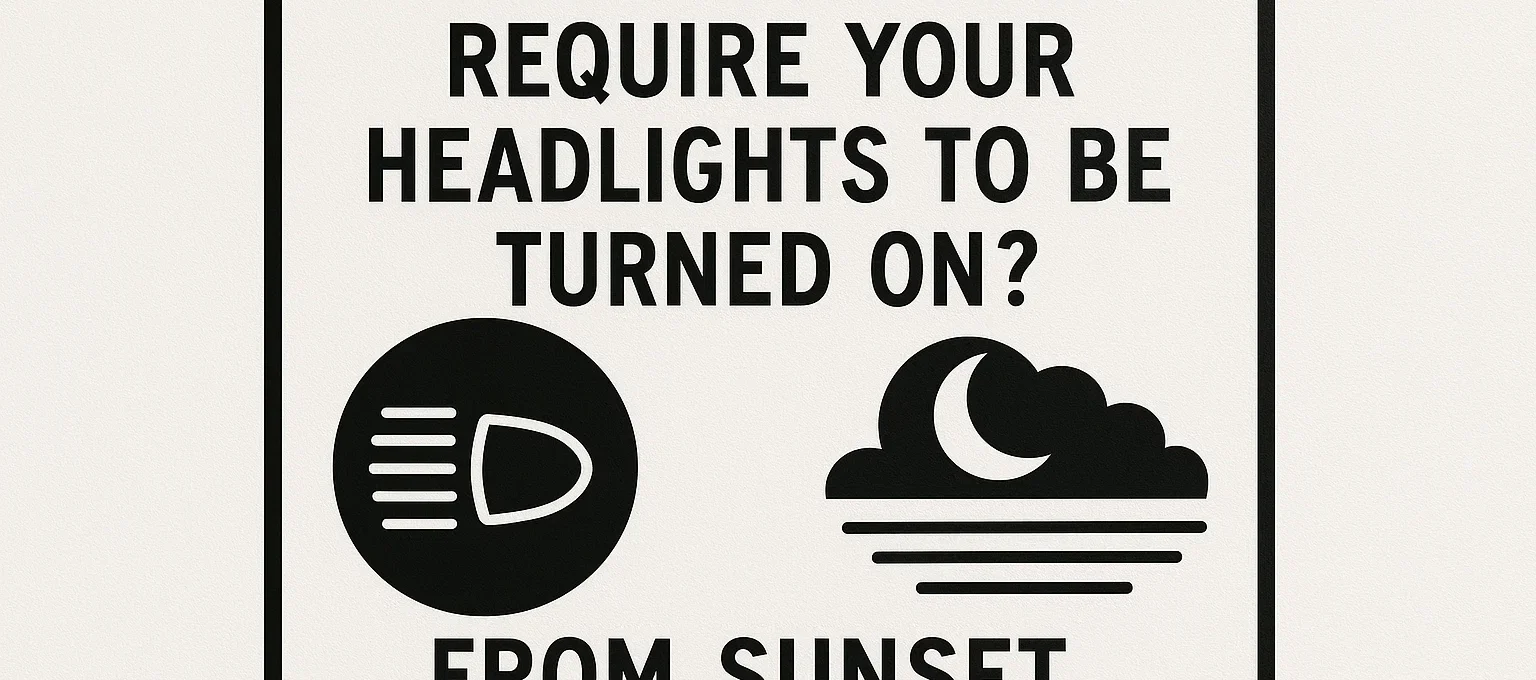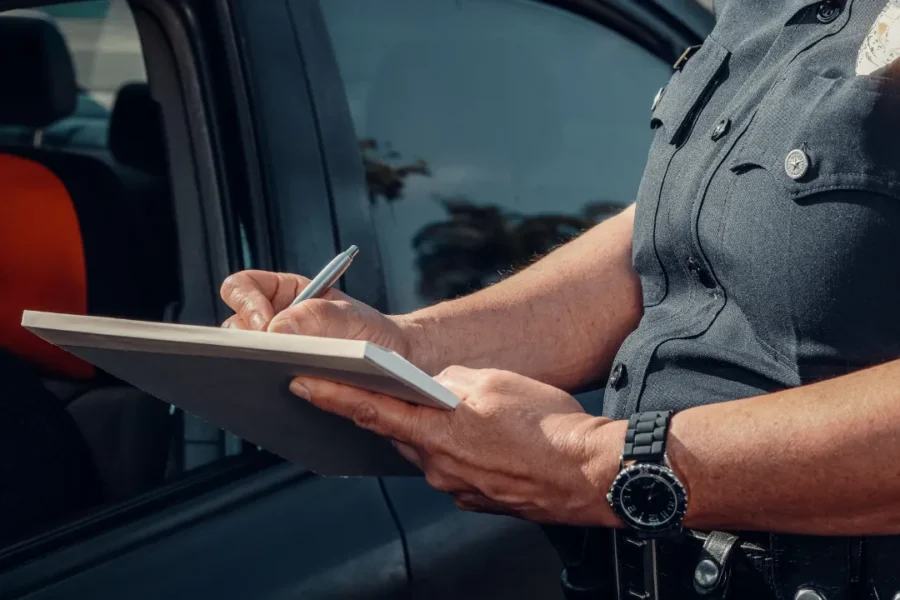Table of Contents
This article explains the legal requirements for turning on vehicle headlights—covering time-based mandates, weather and visibility triggers, “wipers-on lights-on” laws, and special scenarios (like tunnels)—to help drivers stay compliant and safe. We know that knowing when to turn on your headlights keeps you safe. It also helps you avoid tickets.
Many drivers ask, “when does the law require your headlights to be turned on?” Laws vary by state. But core rules focus on time, weather, and visibility.
We cover these rules in detail. You will learn general requirements first. Then we dive into specifics.
General Headlight Use Requirements

Most states require headlights from 30 minutes after sunset until 30 minutes before sunrise. Some states keep it simple. They say sunset to sunrise.
This rule ensures drivers see at night. It also makes cars visible to others. Always check your state’s exact times.
The legal sunset means when the sun sits 6 degrees below the horizon. This happens about 30 minutes after visible sunset. Sunrise works the same way.
Visibility-Based Headlight Rules
Headlights turn on when visibility drops. Many states set this at less than 1,000 feet. These include California, Delaware, Illinois, Kansas, Maine, Maryland, Nebraska, Nevada, New Hampshire, New York, North Dakota, Ohio, Oklahoma, Oregon, Pennsylvania, Texas, Utah, Vermont, Washington, and Wyoming.
Other states use 500 feet. Alabama, Arkansas, Connecticut, Florida, Georgia, Hawaii, Idaho, Indiana, Iowa, Kentucky, Louisiana, Massachusetts, Michigan, Minnesota, Mississippi, Missouri, Montana, New Jersey, New Mexico, Oklahoma, Rhode Island, South Carolina, South Dakota, Tennessee, Virginia, West Virginia, and Wisconsin follow this.
North Carolina sets it at 400 feet. South Dakota and Tennessee go lower. They require lights at 200 feet.
These rules apply day or night. Poor visibility triggers them. Fog, rain, or dust can reduce sight.
Drivers must judge visibility. If you cannot see far, turn on lights. This prevents accidents, when does the law require your headlights to be turned on?
Daytime Headlight Use
Headlights help during the day too. Bad weather like fog, rain, or snow demands them. Many states require lights if wipers run.
In 42 states, “wipers on, lights on” is the law. New York and California enforce this. It boosts safety in low visibility.
Headlights also apply in special spots. Narrow mountain passes need them. Winding roads too.
Construction zones require lights in 37 states. These include Colorado, Connecticut, Idaho, Illinois, Iowa, Maine, Maryland, Michigan, Minnesota, Missouri, Nebraska, New Jersey, New York, North Dakota, Ohio, Oklahoma, Rhode Island, South Dakota, Utah, Vermont, West Virginia, Wisconsin, and Wyoming.
California mandates daytime lights on mountain roads. Pennsylvania does in work zones. Lights make your car stand out.
The main goal is visibility. On mountains, cars blend in. Lights warn around bends.
In zones, workers spot you easier. This cuts risks. Studies back this up.
The National Highway Traffic Safety Administration found benefits. Daytime lights cut crashes for trucks and vans by 5.7 percent. Pedestrian accidents drop 12 percent.
Motorcycle crashes fall 23 percent. Vehicles with lights get seen 94 percent faster. “24/7 headlight use” reduces daytime wrecks, when does the law require your headlights to be turned on?
Daytime Running Lights vs. Regular Headlights

Daytime running lights differ from regular ones. They shine dimmer. They skip the rear lights.
DRLs make your car visible in daylight. They do not help you see at night. They run at 2,000 to 3,000 lumens.
Their beam reaches 100 to 200 feet. Color temperature hits 5,000 to 6,000K, cool white. They use 5 to 10 watts.
NHTSA caps DRLs at 7,000 candela. They are not substitutes for headlights. Use regular lights in twilight or bad weather.
Canada, Norway, Denmark, and the UK mandate DRLs. The U.S. does not yet. Always check laws.
Types of Headlights
We explain headlight types next. Low beams suit normal night drives. They handle poor visibility.
Low beams give 4,000 to 6,000 lumens. Beam range is 200 to 300 feet. Color temperature: 4,000 to 4,500K, neutral white.
They consume 25 to 65 watts. Intensity: 15,000 to 40,000 candela. Use them most times.
High beams fit rural dark areas. They provide 8,000 to 12,000 lumens. Beam reaches 350 to 500 feet.
Color: 4,000 to 5,000K, neutral to cool white. Power: 55 to 65 watts. Intensity: 40,000 to 75,000 candela.
Fog lights aid in bad weather. They offer 1,500 to 2,500 lumens. Beam: 100 to 150 feet.
Color: 2,700 to 3,500K, warm white or yellow. Power: 20 to 35 watts. Intensity: 5,000 to 12,000 candela.
They cut through fog or rain. Low, wide beam helps. They do not replace headlights, when does the law require your headlights to be turned on?
Headlight Technology Comparison
Different technologies exist for headlights. We compare them in a table. This shows pros and cons.
| Technology Type | Average Lifespan | Energy Efficiency | Initial Cost | Color Options | Notable Features |
|---|---|---|---|---|---|
| Halogen | 500-1,000 hrs | 15-20 lm/w | Low | Limited | Industry standard, easily replaceable |
| LED | 30,000-50,000 hrs | 70-150 lm/w | Medium-High | Multiple | Long life, low heat, instant on |
| HID/Xenon | 2,000-3,000 hrs | 60-100 lm/w | High | Multiple | Very bright, requires warm-up |
| Laser | 50,000+ hrs | 170+ lm/w | Very High | Limited | Longest range, newest technology |
Choose based on needs. Halogen costs less. LED lasts longer.
High Beam Dimming Rules
Dim high beams near others. Do it within 500 feet of approaching cars. This prevents glare.
When following, dim within 200 to 300 feet. Iowa says 400 feet. Oklahoma: 600 feet.
Montana requires 500 feet when following. Kentucky wants high beams to see 350 feet ahead. Follow these to stay safe.
Penalties for Violations
Breaking headlight laws brings penalties. Fines range from $25 to $200 for first offenses. It counts as a moving violation.
Points add to your record. In accidents, no lights mean negligence. Insurance may deny claims.
One headlight out is illegal everywhere. Fines: $25 to $150. Fix-it tickets give 24 to 72 hours.
It fails safety checks. Points may apply. Officers can stop you just for this, when does the law require your headlights to be turned on?
Headlight Maintenance Tips

Check headlights monthly. Test all lights. Fix issues fast.
Yellow lenses cut output by 80 percent. Clean them often. Halogen lights reach 300 to 500 feet.
HID and LED go 500 to 1,000 feet. 31 states require annual inspections. Align every two years.
Do it after collisions. Proper care keeps you legal. It boosts safety.
Virginia-Specific Headlight Laws
when does the law require your headlights to be turned on?, Virginia requires lights from sunset to sunrise. Use them if visibility drops below 500 feet. This covers people or cars.
Lights on with continuous wipers in fog, rain, sleet, or snow. Intermittent wipers in mist skip this. No citation unless stopped for other reasons.
No points for this alone. Blue LED bulbs are banned. Tinted headlights too.
Only white or amber allowed. Use up to four lights total. Two headlights plus two fog or auxiliary.
Motorcycles get five. Dim for objects under 350 feet. Dim when approaching under 500 feet.
Dim when following under 200 feet. These rules keep roads safe.
Special Scenarios for Headlights
Tunnels often require headlights. Laws vary by state. Always turn them on inside.
This helps you see. Others see you too. Mountain passes need them.
Construction zones as well. Winding roads benefit from lights. Stay alert in these spots.
When does the law require your headlights to be turned on? It depends on time and conditions. Follow rules to avoid issues.
We covered key points. Stay safe on roads. Check local laws often.
FAQs
When should I turn on my headlights at night?
Turn them on 30 minutes after sunset. Keep them until 30 minutes before sunrise. Check state rules.
Do I need headlights in rain during the day?
Yes, if wipers run continuously. 42 states require this. It improves visibility.
Are daytime running lights enough at twilight?
No, they are dimmer. Use regular headlights then. Laws demand full lights.
What happens if I drive with one headlight out?
You get a fine of $25 to $150. Fix it fast. It’s illegal everywhere.
Must I dim high beams near other cars?
Yes, within 500 feet approaching. 200 to 300 feet when following. States vary slightly.
In this article, don’t give any financial advice.






